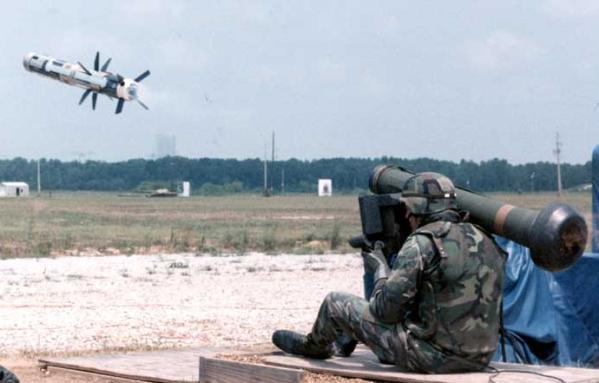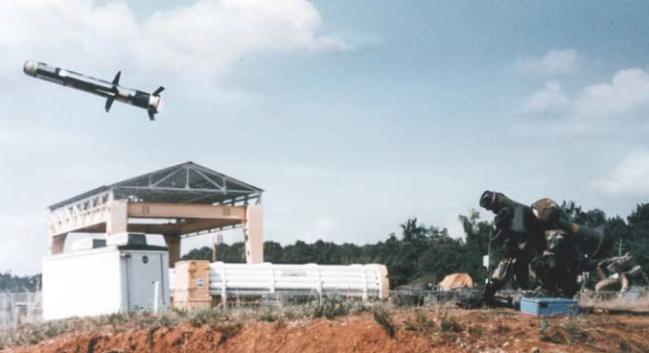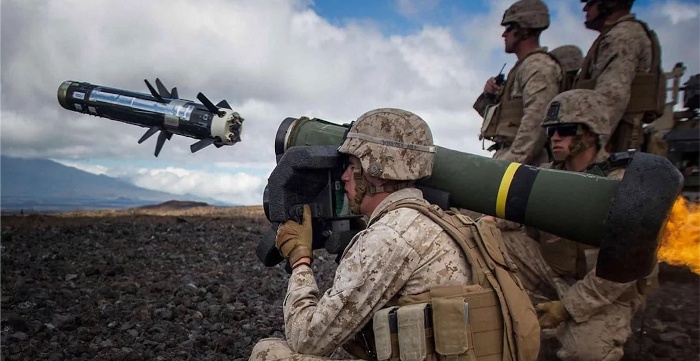Raytheon/Lockheed Martin (Hughes/Martin Marietta) FGM-148 Javelin
The Javelin is the first man-portable fire-and-forget anti-armour missile in service with U.S. Army and Marine Corps ground forces, and as such has replaced the older FGM-77 Dragon.
Following cancellation of the FGR-17 Viper program, the U.S. Army formally established the AAWS-M (Advanced Anti-Tank Weapon System - Medium) requirement for a man-portable guided anti-armour missile in December 1983. In 1985, the AAWS-M was approved for development, and in August 1986, the AAWS-M POP (Proof of Principle) phase began with contracts let to three competitors. The POP phase was completed in late 1988, and in June 1989, the full-scale development contract was awarded to a joint venture of Texas Instruments and Martin Marietta (now Raytheon and Lockheed Martin). The AAWS-M missile was designated FGM-148A and named Javelin. The first test flight of a Javelin round succeeded in April 1991, and in March 1993, the first firing from the portable launcher occurred. Low-rate initial production was approved in June 1994, and in 1996, the first Javelin missiles were deployed with operational U.S. Army units.
 |
| Photo: U.S. Army |
| FGM-148A |
A complete Javelin system consists of the CLU (Command Launch Unit) and the FGM-148A missile in its disposable launch tube. Before firing, the reusable CLU is mated with the launcher, and the gunner has to find a target through the CLU's sights. He can either use the day sight (4x magnification) or the thermal (infrared) imaging night sight (4x or 9x magnification). When a target has been selected by centering its image in a box in the sight, the gunner locks the missile's tracking system on the target. The gunner also has to choose between a top attack, where the target is hit from above (used for tanks), and a direct attack, where the target is hit head-on (e.g. for buildings). When the trigger is pulled, the FGM-148A is ejected from the tube by a low-g soft launch motor. This keeps the recoil forces down, and makes the system usable e.g. from within buildings or vehicles. When the missile has cleared the tube, the main motor ignites, and the six small wings and four tail fins flip out. The FGM-148A flies at altitudes above ground of up to 50m (160 ft) for the direct attack or 150 m (490 ft) for the top attack mode. The Javelin's IIR (Imaging Infrared) seeker with its staring focal plane array will guide the missile to the target, and the tandem shaped charge warhead detonates on impact. The warhead section consists of a precursor warhead to defeat ERA (Explosive Reactive Armour) and a main warhead to penetrate up to 800 mm of conventional armour.
 |
| Photo: U.S. Army |
| FGM-148A |
The tests with the Javelin EMD and LRIP rounds resulted in some internal changes to simplify production and reduce cost. This improved variant, which is presumably the full-rate production version, is known as the EPP (Enhanced Producibility Program) configuration. The designation FGM-148B, allocated at some time between 1996 and 1998, most probably refers to the EPP missile. In April 1999, the designation FGM-148C was allocated to an improved FGM-148B, but details of the upgrade are unclear. The FGM-148D is a modification of the FGM-148C for non-US customers.
The Javelin's true fire-and-forget capability allows the operator to go for cover and/or reload another round as soon as the missile has left the launch tube. This feature alone makes it vastly superior to the FGM-77 Dragon, and the latter was phased-out by the U.S. Army in favour of Javelin. Javelin deployment by the U.S. Marine Corps lagged slightly behind that of the Army, possibly because the Marines used upgraded variants of the Dragon. The USMC deployed the first Javelins in 1998/99.
In the 2013/14 time frame, development of the FGM-148E version, also known as "Spiral 1", began. It featured new electronics in the missile's control section to save weight and production costs. Full-rate production of the FGM-148E began in 2017. The next development step was labeled "Spiral 2", and resulted in the FGM-148F missile. It has a Multi-Purpose Warhead (MPWH), which is still effective against modern armor, but also features enhanced fragmentation for increased effectiveness against soft and unarmored targets. The FGM-148F is in full production since May 2020. The latest Javelin missile upgrade is known as "Spiral 3". It covers a new launch-tube assembly and battery unit, and the improved FGM-148G missile with new guidance section and seeker. Development began around 2021, but the program is significantly delayed because of problems during testing. At the time of this writing, no production decision has been announced. In parallel to the FGM-148G missile upgrade, a new CLU known as LW CLU (Light-Weight CLU) is also being developed. It is lighter and slightly smaller than the existing CLU, but can fire any variant of the FGM-148 missile.
 |
| Photo: Raytheon |
| FGM-148F |
More than 50000 Javelin missiles have been delivered so far, and production is ongoing with the FGM-148F version.
Specifications
Note: Data given by several sources show slight variations. Figures given below may therefore be inaccurate!
Data for FGM-148A:
| Length | 1.08 m (3 ft 6.6 in) |
| Finspan | 38 cm (15 in) |
| Diameter | 12.7 cm (5 in) |
| Weight | 11.8 kg (26.1 lb); complete system (missile+tube+CLU): 22.3 kg (49.2 lb) |
| Speed | ? |
| Range | 2500 m (8200 ft) |
| Propulsion | Two-stage (eject/sustain) solid-fueled rocket motor |
| Warhead | 8.4 kg (18.6 lb) tandem shaped charge |
Main Sources
[1] Hajime Ozu: "Missile 2000 - Reference Guide to World Missile Systems", Shinkigensha, 2000
[2] Redstone Arsenal Historical Information Website
[3] Army Technology Website:
Javelin
Portable Anti-Tank Missile, 2023
[4] Javelin Close Combat Missile System - Medium, 2017
Back to Current Designations Of U.S. Unmanned Military Aerospace Vehicles
Back to Directory of U.S. Military Rockets and Missiles
Last Updated: 17 December 2024